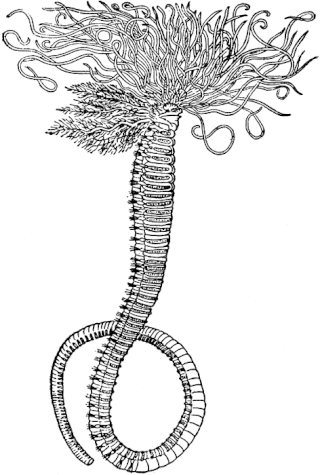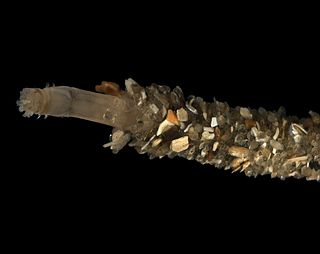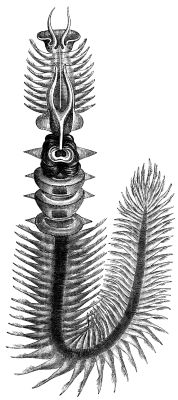Polychaeta is a paraphyletic class of generally marine annelid worms, commonly called bristle worms or polychaetes. Each body segment has a pair of fleshy protrusions called parapodia that bear many bristles, called chaetae, which are made of chitin. More than 10,000 species are described in this class. Common representatives include the lugworm and the sandworm or clam worm Alitta.

Sabellidae, or feather duster worms, are a family of marine polychaete tube worms characterized by protruding feathery branchiae. Sabellids build tubes out of a tough, parchment-like exudate, strengthened with sand and bits of shell. Unlike the other sabellids, the genus Glomerula secretes a tube of calcium carbonate instead. Sabellidae can be found in subtidal habitats around the world. Their oldest fossils are known from the Early Jurassic.

The Chaetopteridae are a family of marine filter-feeding polychaete worms that live in vertical or U-shaped tubes in tunnels buried in the sedimentary or hard substrate of marine environments. The worms are highly adapted to the hard tube they secrete. Inside the tube the animal is segmented and regionally specialized, with highly modified appendages on different segments for cutting the tunnel, feeding, or creating suction for the flow of water through the tube home. The modified segments for feeding are on the 12th segment from the head for members of this family.

Chaetopterus or the parchment worm or parchment tube worm is a genus of marine polychaete worm that lives in a tube it constructs in sediments or attaches to a rocky or coral reef substrate. The common name arises from the parchment-like appearance of the tubes that house these worms. Parchment tube worms are filter feeders and spend their adult lives in their tubes, unless the tube is damaged or destroyed. They are planktonic in their juvenile forms, as is typical for polychaete annelids. Species include the recently discovered deep water Chaetopterus pugaporcinus and the well-studied Chaetopterus variopedatus.

Pomatoceros triqueter is a species of tube-building annelid worm in the class Polychaeta. It is common on the north eastern coasts of the Atlantic Ocean and in the Mediterranean Sea.

Hydroides norvegica is a species of tube-forming annelid worm in the family Serpulidae. It is found on submerged rocks, shells, piles and boats in many coastal areas around the world. It is the type species of the genus Hydroides.

Spirorbis borealis is a sedentary marine polychaete worm in the Serpulidae family. It is commonly called the sinistral spiral tubeworm and is the type species of the genus Spirorbis.

Sabellastarte spectabilis is a species of benthic marine polychaete worm in the Sabellidae family. It is commonly known as the feather duster worm, feather duster or fan worm. It is native to tropical waters of the Indo-Pacific but has spread to other parts of the world. It is popular in aquariums because of its distinctive appearance and its ability to remove organic particles and improve water quality.

Phyllodocida is an order of polychaete worms in the subclass Aciculata. These worms are mostly marine, though some are found in brackish water. Most are active benthic creatures, moving over the surface or burrowing in sediments, or living in cracks and crevices in bedrock. A few construct tubes in which they live and some are pelagic, swimming through the water column. There are estimated to be more than 4,600 accepted species in the order.
Pinnixa chaetopterana, the tube pea crab, is a small decapod crustacean that lives harmlessly within the tube of the polychaete worm, Chaetopterus variopedatus.

Amphitrite ornata or ornate worm, is a species of marine polychaete worm in the family Terebellidae.

Cirratulus cirratus is a species of marine polychaete worm in the family Cirratulidae. It occurs in the littoral and sub-littoral zones of the Atlantic Ocean.

Lanice conchilega, commonly known as the sand mason worm, is a species of burrowing marine polychaete worm. It builds a characteristic tube which projects from the seabed, consisting of cemented sand grains and shell fragments with a fringe at the top.
Abarenicola pacifica or the Pacific lugworm is a large species of polychaete worm found on the west coast of North America and also in Japan. The worms live out of sight in burrows under the sand and produce casts which are visible on the surface.

Lagis koreni, commonly known as the trumpet worm, is a species of marine polychaete worm found in European waters. It lives within a narrow conical tube made of grains of sand and shell fragments.

Oweniidae is a family of marine polychaete worms in the suborder Sabellida. The worms live in tubes made of sand and are selective filter feeders, detritivores and grazers.

Eudistylia polymorpha, the giant feather duster worm, is a species of marine polychaete worm belonging to the family Sabellidae. Its common name is from the crown of tentacles extended when the animal is under water.
The Onuphidae are a family of polychaete worms.

Poecilochaetus serpens is a species of marine polychaete worm in the family Poecilochaetidae. It is a benthic worm that burrows into soft sediment.
Diopatra claparedii is a species of tube-building polychaete worm of the family Onuphidae. It is found dispersed along intertidal and subtidal benthic environments of South Asian waters, especially along the coasts of Malaysia, Singapore, Thailand, and the Philippines. This species is exploited by humans for fishing bait, indication of marine pollution, and as gold and silver nanoparticle biosynthesis agents.

















